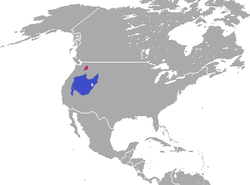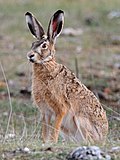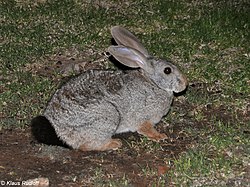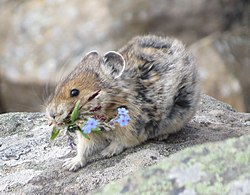| Name | Authority and species | Range | Size and ecology |
|---|
| Brachylagus  | Miller, 1900
| Western America (introduced in red)
 | Size: 23–30 cm (9–12 in) long, plus 1–3 cm (0.4–1.2 in) tail [3]
Habitats: Shrubland and desert [4]
Diet: Sagebrush, as well as grass and other plants [3] |
|---|
| Bunolagus  | Thomas, 1929
| Southern South America
 | Size: 33–47 cm (13–19 in) long, plus 7–11 cm (3–4 in) tail [5]
Habitat: Shrubland [6]
Diet: Shrubs as well as grass [6] |
|---|
| Caprolagus  | Blyth, 1845
| Himalayas
 | Size: 38–50 cm (15–20 in) long, plus 2–4 cm (1–2 in) tail [7]
Habitats: Grassland and inland wetlands [8]
Diet: Grass as well as other plants [8] |
|---|
Lepus
(hare)  | Linnaeus, 1758
| Africa, Asia, Europe, and North America | Size range: 28 cm (11 in) long, plus 5 cm (2 in) tail (Yarkand hare) to 76 cm (30 in) long (Desert hare) [9]
Habitats: Desert, coastal marine, inland wetlands, forest, shrubland, rocky areas, savanna, caves, and grassland [10]
Diets: Wide variety of plants [10] |
|---|
Nesolagus
(striped rabbit)  | Major, 1899
| Sumatra and the Annamite Range in Laos and Vietnam
 | Size range: 35 cm (14 in) long (Annamite striped rabbit) to 42 cm (17 in) long plus 17 cm (7 in) tail (Sumatran striped rabbit) [11]
Habitat: Forest [12]
Diets: Various plants [12] |
|---|
| Oryctolagus  | Lilljeborg, 1762
| Europe, southern South America, and Oceana (native in orange, introduced in purple)
 | Size: 38–50 cm (15–20 in) long [13]
Habitats: Forest, savanna, shrubland, and grassland [14]
Diet: Grass, leaves, buds, bark, and roots [13] |
|---|
| Pentalagus  | Lyon, 1904
| Southern tip of Japan
 | Size: 39–53 cm (15–21 in) long, plus 2–4 cm (1–2 in) tail [15]
Habitats: Forest, shrubland, and intertidal marine [16]
Diet: Herbs, shrubs, and acorns [16] |
|---|
| Poelagus | St. Leger, 1932
| Central Africa
 | Size: 45–50 cm (18–20 in) long, plus 4–5 cm (1.6–2.0 in) tail [17]
Habitats: Forest, savanna, and rocky areas [18]
Diet: Grass, shrubs, forbs, and tubers [17] |
|---|
Pronolagus
(red rock hare)  | Lyon, 1904
| Southern Africa (P. crassicaudatus in purple, P. randensis in green, P. rupestris in orange, and P. saundersiae in blue)
 | Size range: 38 cm (15 in) long, plus 5 cm (2 in) tail (Hewitt's red rock hare) to 56 cm (22 in) long plus 11 cm (4 in) tail (Natal red rock hare) [19]
Habitats: Desert, grassland, shrubland, and rocky areas [20]
Diets: Grass, herbs, and shrubs [20] |
|---|
| Romerolagus  | Merriam, 1896
| Southern Mexico
 | Size: 27–32 cm (11–13 in) long, plus 1–4 cm (0.4–1.6 in) tail [21]
Habitats: Forest and grassland [22]
Diet: Grass [21] |
|---|
Sylvilagus
(cottontail rabbit)  | Gray, 1867
| North America and South America
 | Size range: 21 cm (8 in) long, plus 1 cm (0.4 in) tail (Tres Marias cottontail) to 55 cm (22 in) long plus 8 cm (3 in) tail (Swamp rabbit) [23]
Habitats: Desert, inland wetlands, intertidal marine, forest, shrubland, rocky areas, savanna, and grassland [24]
Diets: Wide variety of plants [24] |
|---|























